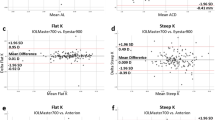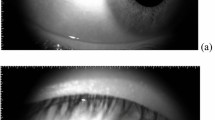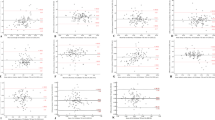Abstract
Purpose
To quantify the biometric changes of ocular dimensions with mechanical elevation of intraocular pressure (IOP) in vivo, to get a better understanding of the elastic properties of the human ocular structures that may play a role in the pathogenesis of various diseases such as myopia or glaucoma.
Methods
Changes in IOP were induced by a suction cup in 18 eyes under cycloplegia. Axial eye length (AEL) and anterior chamber depth (ACD) were measured with non-invasive laser interferometry during elevation of the IOP 10 and 20 mmHg over baseline values and after a 10-min resting period.
Results
IOP elevation of 10 and 20 mmHg respectively caused a significant increase of AEL of 23 μm (95% confidence interval: 14–34 μm) and 39 μm (confidence interval (CI): 28–51 μm). After mechanical oculopression, which resulted in an IOP reduction of –5.1 mmHg (CI: −6.3 to −4.0 mmHg) vsbaseline, a significant shortening of −7 μm (CI: −13 to 0 μm) was observed. The change in AEL correlated with the change in IOP (r=0.66, P=0.005). Furthermore, a significant increase in ACD of 30 μm (CI: 24–36 μm) was detected with IOP reduction after oculopression, but no change was seen during IOP elevation.
Conclusions
Biometric changes of the human eye as a response to IOP changes were assessed in vivo. The correlation between change in AEL and IOP found emphasizes the need of in vivoocular rigidity measurements in the human eye.
Similar content being viewed by others
Introduction
Intraocular pressure (IOP) plays an important role in the pathogenesis of glaucoma and has been hypothesized to be one of several factors implicated in the pathogenesis of myopia and age-related macular degeneration. Elevated IOP was assumed to impose scleral stress and creep, resulting in axial eye elongation with scleral stretch.1 Several studies have evaluated the relation between IOP and myopia development (predominantly in children and animal models) with controversial results: some studies reported a positive association,2, 3, 4 whereas others found no relation between IOP and myopia.5, 6, 7 However, the nature and extent of the influence of IOP on eye growth remain poorly understood.
Rather than IOP, ocular rigidity is thought to play an important role in the pathogenesis of myopia. The human sclera was found to be related to the refractive status insofar that scleral rigidity was lower in myopes than non-myopes.8 Other studies, however, revealed a poor correlation between the degree of myopia and ocular rigidity.9, 10 A recent study demonstrated a positive correlation between ocular rigidity and age of patients, whereas there was no correlation between ocular rigidity and axial eye length.11
In a previous study, a shortening of axial eye length by 46 μm was found with pharmacological IOP reduction (Kiss B et al. IOVS 1999; ARVO abstract 2379). However, it is unclear as to how far the pharmacological agent used, in that case the antiglaucomatous drug timolol, directly influenced choroidal thickness and therefore axial eye length.
The aim of this study was to investigate the effect of short-term mechanical IOP elevation and the effect of oculopression on ocular dimensions in emmetropic eyes.
Material and methods
All the research and measurements followed the tenets of the Helsinki agreement. Informed consent was obtained from all subjects in this study after the nature and possible consequences of the study had been explained. The study was approved by the ethics committee of the Medical University of Vienna.
Eighteen eyes of 18 healthy subjects (mean age: 25 years range: 19–29 years) were included in this open pilot study. All subjects had a spherical equivalent (SE) refractive error of less than ±0.5 D and no history of ocular disease, trauma, or surgery. None of the subjects used topical or systemic medications. Before inclusion, a complete ophthalmic examination including a retinal examination after pupil dilatation was performed. Intraocular pressure was measured by Goldmann tonometry and refractive error was measured under cycloplegia with an autorefractometer (Zeiss Humphrey Automatic Refraktometer Model 597, Zeiss Meditec, Jena, Germany).
Axial eye length (AEL), defined as the distance from the anterior corneal surface to the retinal pigment epithelium, was measured with the IOL Master (Zeiss Meditec, Jena, Germany) using partial coherence laser interferometry (PCI). The principle of this biometry technique has been described in detail previously.12, 13, 14 A novel commercially available interferometer, the AC Master (Zeiss Meditec, Jena, Germany), that is based on the same measurement principle was used to measure central corneal thickness (CCT), anterior chamber depth (ACD), and lens thickness (LT). CCT was defined as the distance from the anterior corneal surface to the posterior corneal surface, ACD as the distance from the anterior corneal surface to the anterior lens surface, and LT as the distance from the anterior lens surface to the posterior lens surface. Eight to ten measurements of AEL, CCT, ACD, and LT were taken in each situation for statistical purposes.
Data are presented as mean value ±95% confidence interval (CI). The precision of PCI is defined as the SD of multiple recorded consecutive measurements of the ocular distance under investigation. The Student's t-test for related samples was used to compare the means, considering P<0.05 for statistical significance.
Intraocular pressure was increased by means of the episcleral suction cup technique.15 With this technique, a suction cup (diameter 11 mm) is applied to the temporal sclera just posterior to the limbus. It produces a negative pressure that is transferred onto the globe and induces a subsequent increase in IOP. In the present study, a suction pressure of 10 and 20 mmHg was applied. A Perkins handheld applanation tonometer (MK 2, Clement Clarke, England) was used to measure IOP. Before each measurement, one drop of oxybuprocaine with fluorescein (Flurekain ‘Croma’, Croma-Pharma, Austria) was instilled into the conjunctival sac for local anaesthesia.
Baseline measurements of AEL, CCT, ACD, LT, and IOP were performed 30 min after instillation of two drops of cyclopentolate (cyclopentolate 1%, ‘Thilo’, Alcon, Austria). Thereafter, the IOP was first increased by 10 mmHg and then again by 20 mmHg over baseline IOP. At each step, the artificially induced increase in IOP was maintained for 5 min plus the time required to complete biometric measurement (not exceeding a total time of 8 min). The IOP was controlled by scleral suction and monitored by applanation tonometry. Ten minutes after the last intervention period, measurements were repeated. These served as measurements after oculopression.
Results
Absolute values of biometric variables and IOP at baseline and ‘suction cup-induced’ increases of 10 and 20 mmHg, as well as after oculopression, are given in Table 1.
Elevating the IOP 10 and 20 mmHg above baseline resulted in significant increases of AEL by 23 μm (95% CI: 14–34 μm, P<0.001) and 39 μm (CI: 28–51 μm, P<0.001), respectively (Figure 1). Ten minutes after removal of the suction cup, AEL shortened by −7 μm (CI: −13 to 0 μm, P<0.05) whereas the IOP decreased by –5.1 mmHg (CI: −6.3 to −4.0 mmHg, P<0.005) compared to baseline values. There was a significant correlation of 0.66 (P<0.005) between the decrease of IOP with the decrease of AEL after oculopression (Figure 2, left graph).
Change in AEL at different IOP values compared to baseline. Negative values indicate a shortening; positive values an elongation of axial eye length. Boxes indicate the interquartile range, whiskers the non-outlier minimum and maximum, and the line in the box represents the median. Outliers (defined as values outside the 1.5 box length range from the upper and lower value of the box) are represented by circles.
The ACD did not change significantly during pressure elevation of 10 and 20 mmHg, (2 μm, CI: −2 to 7 μm, P=0.33 and 5 μm, CI: 0–11 μm, P=0.09) (Figure 3). However, with IOP reduction after suction cup removal, there was a significant increase in ACD of 30 μm (CI: 24–36 μm, P<0.001) compared to baseline. The correlation between the decrease of IOP and increase of ACD was 0.49 (P<0.05) (Figure 2, right graph). ACD changes were not related to a change in LT that showed small, not clinically relevant changes. Also CCT did not change significantly at any time.
Change in ACD at different IOP values compared to baseline. Negative values indicate a decrease; positive values an increase of ACD. Boxes indicate the interquartile range, whiskers the non-outlier minimum and maximum, and the line in the box represents the median. Outliers (defined as values outside the 1.5 box length range from the upper and lower value of the box) are represented by circles, and extreme values (defined as values outside the 3 box length range from the upper and lower value of the box) by stars.
The precision for AEL measurements as assessed with the IOL Master was 15 μm (range: 9–23 μm), whereas the precision for CCT, ACD, and LT measurements as assessed with the AC Master was 1.3 μm (range: 0.7–1.9), 3.8 μm (range: 1.5–7.6 μm), and 3.2 μm (range: 1.4–6.4 μm), respectively.
Discussion
With short-term elevation of IOP using the suction cup method, we found a significant increase of AEL. The IOP reduction following the removal of the suction cup resulted in a significant decrease in AEL and a deepening of ACD compared to baseline values. These biometric changes correlated well with the IOP reductions.
Several studies have shown a decrease of axial eye length with lowered intraocular pressure, as seen after trabeculectomy16, 17, 18 or after pharmacological treatment.19 A previous study (Kiss B et al. IOVS 1999; ARVO Abstract 2379) showed an AEL shortening of 46 μm (range: 15–70 μm) with a pharmacologically induced reduction of IOP of 5.7 mmHg (range: 3.2–8.3 mmHg). Therefore, the resulting AEL decrease per mmHg IOP decrease was 6.5 μm/mmHg. In the present study, axial eye length change after oculopression was less pronounced with 2 μm/mmHg (range: 0–4 μm/mmHg). One explanation for this discrepancy could be a direct pharmacological effect of timolol 0.5%, used in the former study, on choroidal blood flow and volume. As the AEL is measured up to the pigment epithelium, it is not possible to discriminate between choroidal thickness and scleral changes by this method. Furthermore, the laser interferometer used in the study by Kiss et al had a better resolution than the IOL Master used in the present study.
Although congenitally glaucomatous eyes show an increased axial eye length,20 until now only animal studies have shown that increases in IOP cause axial eye elongation, also referred to as scleral creep.21, 22 This pressure-dependent scleral creep also increases with temperature, as shown in enucleated eyes.23 We have shown IOP-dependent AEL changes in human eyes in vivo for the first time.
Pressure elevation with the suction cup occurs via suction of the sclera to the cup.24 As the IOP increases, the sclera is stretched resulting in an expansion of the eyeball. This expansion with IOP change is dependent on the eye's scleral rigidity and elasticity. After termination of IOP elevation, as a result of oculopression, the IOP decreases compared to baseline values. This IOP reduction resulted in a concomitant shortening of AEL. This shortening could be a result of a decrease in scleral length owing to the reduced IOP or an increase in choroidal blood flow compensating the reduced ocular fundus pulsations during the increased IOP phase.25
It was interesting that an increase in ACD, therefore a posterior shift of the lens, was found after oculopression. Increased outflow of aqueous during oculopression should result in reduced aqueous volume and thus in a reduction of ACD. However, simultaneous reduction of AEL and increase of ACD reflects a reduction in vitreous volume. Using Silvers' formula of the pressure–volume relation based on previous measurements of ocular rigidity made on living human eyes,26 the calculated volume reduction as a result of the reduced AEL (6 μl) and the effect of backward movement of the posterior lens pole and, therefore, anterior vitreous surface (10 μl) should lead to a total loss of vitreous volume of 16 μl on average. According to Quigley, et al27 an increase of pressure behind the vitreous (e.g. choroidal swelling or scleral compression) increases the absolute pressure difference within the eye — higher in the posterior segment than in the anterior segment. As a consequence, fluid passes from the vitreous and into the posterior chamber of the anterior segment where it exits through the trabecular meshwork and uveoscleral outflow paths. Therefore, a concomitant deepening of the ACD should be seen as shown in our study.
In this study, we were able to show biometric changes of the human eye in vivo as a response to IOP changes of short duration. Although a deformation of the entire sclera with the suction cup cannot be fully excluded, the decrease of AEL seen with the decrease of IOP following oculopression gives evidence to a direct interaction of IOP and expansion/contraction of the eye. Scleral rigidity and elasticity of the human eye, as a limiting factor to expansion and contraction forces, obviously play an important role in AEL–IOP relationship. The posterior shift of the lens seen after oculopression indicates a dehydration of the vitreous with scleral compression as a consequence of a pressure gradient within the eye between the posterior and anterior segments. With our experimental set-up, it should be possible to assess scleral rigidity in the human eye in vivo. Such measurements may be relevant to further examine the pathogenesis of a variety of ocular diseases, including glaucoma or myopia.
References
Pruett RC . Progressive myopia and intraocular pressure: what is the linkage? A literature review. Acta Ophthalmol Suppl 1988; 185: 117–127.
Edwards MH, Chun CY, Leung SS . Intraocular pressure in an unselected sample of 6- to 7-year-old Chinese children. Optom Vis Sci 1993; 3: 198–200.
Quinn GE, Berlin JA, Young TL, Ziylan S, Stone RA . Association of intraocular pressure and myopia in children. Ophthalmology 1995; 2: 180–185.
Jensen H . Myopia progression in young school children and intraocular pressure. Doc Ophthalmol 1992; 3: 249–255.
Edwards MH, Brown B . IOP in myopic children: the relationship between increases in IOP and the development of myopia. Ophthalmic Physiol Opt 1996; 3: 243–246.
Goss DA, Caffey TW . Clinical findings before the onset of myopia in youth: 5. Intraocular pressure. Optom Vis Sci 1999; 5: 286–291.
Lee AJ, Saw SM, Gazzard G, Cheng A, Tan DT . Intraocular pressure associations with refractive error and axial length in children. Br J Ophthalmol 2004; 1: 5–7.
Castren JA, Pohjola S . Refraction and scleral rigidity. Acta Ophthalmol (Copenh) 1961; 39: 1011–1014.
Wong E, Yap M . Factors affecting ocular rigidity in the Chinese. Clin Exp Optom 1991; 74: 156–159.
Schmid KL, Li RW, Edwards MH, Lew JK . The expandability of the eye in childhood myopia. Curr Eye Res 2003; 2: 65–71.
Pallikaris IG, Kymionis GD, Ginis HS, Kounis GA, Tsilimbaris MK . Ocular rigidity in living human eyes. Invest Ophthalmol Vis Sci 2005; 2: 409–414.
Findl O, Drexler W, Menapace R, Bobr B, Bittermann S, Vass C et al. Accurate determination of effective lens position and lens–capsule distance with 4 intraocular lenses. J Cataract Refract Surg 1998; 8: 1094–1098.
Drexler W, Baumgartner A, Findl O, Hitzenberger CK, Sattmann H, Fercher AF . Submicrometer precision biometry of the anterior segment of the human eye. Invest Ophthalmol Vis Sci 1997; 7: 1304–1313.
Fercher A, Roth E . Ophthalmic laser interferometry. Proc SPIE 1986; 658: 48–51.
Ulrich WD, Ulrich C . Oculo-oscillo-dynamography: a diagnostic procedure for recording ocular pulses and measuring retinal and ciliary arterial blood pressures. Ophthalmic Res 1985; 5: 308–317.
Cashwell LF, Martin CA . Axial length decrease accompanying successful glaucoma filtration surgery. Ophthalmology 1999; 12: 2307–2311.
Nemeth J, Horoczi Z . Changes in the ocular dimensions after trabeculectomy. Int Ophthalmol 1992; 4–5: 355–357.
Kook MS, Kim HB, Lee SU . Short-term effect of mitomycin-C augmented trabeculectomy on axial length and corneal astigmatism. J Cataract Refract Surg 2001; 4: 518–523.
Arranz-Marquez E, Teus MA . Relation between axial length of the eye and hypotensive effect of latanoprost in primary open angle glaucoma. Br J Ophthalmol 2004; 5: 635–637.
Sampaolesi R, Caruso R . Ocular echometry in the diagnosis of congenital glaucoma. Arch Ophthalmol 1982; 4: 574–577.
Tokoro T . Experimental myopia in rabbits. Invest Ophthalmol 1970; 12: 926–934.
Mohan M, Rao VA, Dada VK . Experimental myopia in the rabbit. Exp Eye Res 1977; 1: 33–38.
Greene PR, McMahon TA . Scleral creep vs temperature and pressure in vitro. Exp Eye Res 1979; 5: 527–537.
Kukán F . Ergebnisse der Blutdruckmessungeb mit einem neuen Ophthalmodynamometer. Z Augenheilkd 1936; 90: 166–191.
Findl O, Strenn K, Wolzt M, Menapace R, Vass C, Eichler HG et al. Effects of changes in intraocular pressure on human ocular haemodynamics. Curr Eye Res 1997; 10: 1024–1029.
Silver DM, Geyer O . Pressure-volume relation for the living human eye. Curr Eye Res 2000; 2: 115–120.
Quigley HA, Friedman DS, Congdon NG . Possible mechanisms of primary angle-closure and malignant glaucoma. J Glaucoma 2003; 2: 167–180.
Acknowledgements
We thank Professor Dr C Vass for his thoughts and thorough discussions concerning the project. The authors have no proprietary interest in any of the materials or equipment mentioned in this study.
Author information
Authors and Affiliations
Corresponding author
Rights and permissions
About this article
Cite this article
Leydolt, C., Findl, O. & Drexler, W. Effects of change in intraocular pressure on axial eye length and lens position. Eye 22, 657–661 (2008). https://doi.org/10.1038/sj.eye.6702709
Received:
Accepted:
Published:
Issue Date:
DOI: https://doi.org/10.1038/sj.eye.6702709
Keywords
This article is cited by
-
Refractive outcomes after immediate primary phacoemulsification for acute primary angle closure
Scientific Reports (2023)
-
Gonioscopy-assisted transluminal trabeculotomy versus goniotomy with Kahook dual blade in patients with uncontrolled juvenile open-angle glaucoma: a retrospective study
BMC Ophthalmology (2021)
-
Refractive outcomes of cataract surgery in primary congenital glaucoma
Eye (2019)
-
Morphological prediction of glaucoma by quantitative analyses of ocular shape and volume using 3-dimensional T2-weighted MR images
Scientific Reports (2019)
-
Relationship between intraocular pressure, anterior chamber depth and lens thickness in primary open-angle glaucoma patients
International Ophthalmology (2018)






